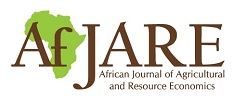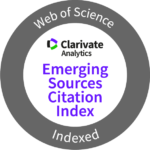


African Journal of Agricultural and Resource Economics (AfJARE)
A publication of the African Association of Agricultural Economists (AAAE)
Latest Publications
Determinants of smallholder farmers’ willingness to pay for improved irrigation systems: Evidence from Northwest, Ethiopia
This study attempted to identify determinants of farmers’ maximum willingness to pay (WTP) for improved use of irrigation water.
Remoteness and its impact on productivity growth among Malawi’s smallholder household farmers: A Malmquist and tobit regression approach
This study examines the impact of remoteness on productivity growth among Malawian smallholder farmers.
Cet article analyse les effets des produits forestiers non ligneux (PFNL) sur la pauvreté multidimensionnelle au Burkina Faso. Il s'appuie sur des données primaires collectées auprès de 384 ménages sélectionnés aléatoirement.
Spatial variability in agricultural yield responses to climate change:Implications for index insurance in Burkina Faso
Index-based insurance has emerged as a compelling strategy for agricultural risk management in Africa, particularly in contexts where smallholder farmers are disproportionately exposed to climate-related hazards.
The current study investigated the impact of using information and communication technology-based weather information services on the adoption of climate change adaptation strategies.
Estimating profit, input demand and output supply elasticities in rice production: Evidence from Vietnam
Understanding rice farmers’ responses to market prices is essential for policy makers to design effective policies to better manage input demand and rice supply. This paper applies duality theory to derive the elasticities of input demand and output supply for Vietnamese rice production using a translog profit function approach.
Volume 19
Soil acidity is a major constraint to crop production in tropical regions. Although agricultural lime is one option to remediate acid soils, there is limited information on the potential returns on investments to liming by smallholders.
This study was carried out to evaluate different spraying regimes for the production of two cowpea varieties (Ife Brown and IT2246) in the humid southwest agro-ecologies of Nigeria in order to recommend optimum spraying regimes for cowpea production in the zone.
The burden of low-quality diets and childhood undernutrition is widespread in rural areas in Sub-Saharan Africa, where households rely mostly on agriculture. Various empirical studies have shown the relative importance of the market, and hence food purchases, compared with farm diversification in raising dietary diversity.
Volume 18 (2023)
This study ascertained the influence of farmers’ perceptions of climate change effects and their household characteristics on the choice of adaptation technologies they adopt. The survey relied mainly on institutional and primary data for its analysis.
In this paper, we explore the role of wildlife in climate change adaptation, especially in areas used predominantly for livestock production in South Africa. Using a sample of 3 449 wildlife and livestock ranches, we estimate a multinomial choice model of various ranching options in these areas. The results indicate that mixed wildlife-livestock ranches are less vulnerable to climate change when compared to ranches with only wildlife or only livestock.
Goat keeping is a common practice among rural farmers due to the adaptability of goats to harsh environments, their efficient forage conversion and rapid growth, and their multiple benefits, including the production of manure and high-quality milk.
Volume 17 (2022)
The adoption of improved agricultural technologies is known to significantly improve incomes, create more wealth, alleviate poverty and contribute to rural development in many developing countries.
One of the three components of Rwanda’s flagship anti-poverty programme, Vision 2020 Umurenge (VUP), is the provision of credit to relatively poor households, nearly all of them farmers. In this paper we estimate the impact of the programme using high-quality household survey data from 2013/2014 and 2016/2017.
Current global trends in population growth, urbanisation and a growing middle-class economy have resulted in increased demand for livestock and products, and more so dairy products. This necessitates the need for livestock producers to respond to the growing demand.


